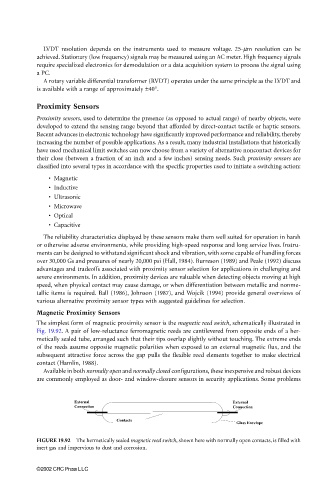Page 488 - The Mechatronics Handbook
P. 488
0066_frame_C19 Page 110 Wednesday, January 9, 2002 5:32 PM
LVDT resolution depends on the instruments used to measure voltage. 25-µm resolution can be
achieved. Stationary (low frequency) signals may be measured using an AC meter. High frequency signals
require specialized electronics for demodulation or a data acquisition system to process the signal using
a PC.
A rotary variable differential transformer (RVDT) operates under the same principle as the LVDT and
is available with a range of approximately ±40°.
Proximity Sensors
Proximity sensors, used to determine the presence (as opposed to actual range) of nearby objects, were
developed to extend the sensing range beyond that afforded by direct-contact tactile or haptic sensors.
Recent advances in electronic technology have significantly improved performance and reliability, thereby
increasing the number of possible applications. As a result, many industrial installations that historically
have used mechanical limit switches can now choose from a variety of alternative noncontact devices for
their close (between a fraction of an inch and a few inches) sensing needs. Such proximity sensors are
classified into several types in accordance with the specific properties used to initiate a switching action:
• Magnetic
• Inductive
• Ultrasonic
• Microwave
• Optical
• Capacitive
The reliability characteristics displayed by these sensors make them well suited for operation in harsh
or otherwise adverse environments, while providing high-speed response and long service lives. Instru-
ments can be designed to withstand significant shock and vibration, with some capable of handling forces
over 30,000 Gs and pressures of nearly 20,000 psi (Hall, 1984). Burreson (1989) and Peale (1992) discuss
advantages and tradeoffs associated with proximity sensor selection for applications in challenging and
severe environments. In addition, proximity devices are valuable when detecting objects moving at high
speed, when physical contact may cause damage, or when differentiation between metallic and nonme-
tallic items is required. Ball (1986), Johnson (1987), and Wojcik (1994) provide general overviews of
various alternative proximity sensor types with suggested guidelines for selection.
Magnetic Proximity Sensors
The simplest form of magnetic proximity sensor is the magnetic reed switch, schematically illustrated in
Fig. 19.92. A pair of low-reluctance ferromagnetic reeds are cantilevered from opposite ends of a her-
metically sealed tube, arranged such that their tips overlap slightly without touching. The extreme ends
of the reeds assume opposite magnetic polarities when exposed to an external magnetic flux, and the
subsequent attractive force across the gap pulls the flexible reed elements together to make electrical
contact (Hamlin, 1988).
Available in both normally open and normally closed configurations, these inexpensive and robust devices
are commonly employed as door- and window-closure sensors in security applications. Some problems
External
External
Connection Connection
Contacts
Glass Envelope
FIGURE 19.92 The hermetically sealed magnetic reed switch, shown here with normally open contacts, is filled with
inert gas and impervious to dust and corrosion.
©2002 CRC Press LLC

